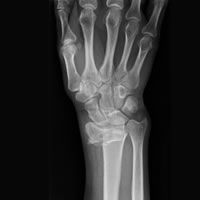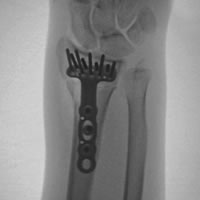Conditions Treated
Wrist Fractures
What is it?
A wrist fracture refers to a break of one or both of the bones of the forearm.
What causes it?
Wrist fractures are one of the most common injuries seen by orthopaedic surgeons. They commonly occur in children following accidents and in the elderly following minor falls onto the outstretched hand. Wrist fractures can also occur in younger patients following high-energy accidents such as skiing or cycling.
What are the symptoms?
Patients generally present with wrist pain after the fall. There is usually associated swelling, bruising and deformity of the wrist. Sometimes people have skin wounds around the wrist caused by the bone penetrating the soft tissues. These are known as open fractures.
Occasionally the resulting deformity of the fracture compresses one of the nerves around the wrist resulting in pins and needles in the fingers; this is called carpal tunnel syndrome.
Do I need any further investigations?
All patients will require x-rays of the wrist and sometimes the hand prior to treatment. In complicated injuries it be necessary for a CT scan to be perfumed before treatment is planned.
What is the treatment?
In order to regain the best possible function of the wrist, the bone and joint surfaces need to be in the correct position and alignment. Once this is achieved the fracture needs to be immobilized to allow the bones to heal in the desired position.
Treatment depends on the severity of the fracture and the age and demands of the patient.
- If the fracture position is satisfactory on the x-ray, then the wrist is immobilized in a below elbow lightweight cast for 4-6 weeks.
- If the fractured bones are out of position, this needs to be rectified; this is achieved by manipulating the bones into a better position under a general anaesthetic. If the fracture is stable following manipulation then the wrist is immobilized in a plaster for 6 weeks. If not then the fracture is stabilized with fine metal wires through the skin and a plaster cast applied for 4-6 weeks, at which point the wires are removed in clinic.
- If the fracture cannot be manipulated, is unstable following manipulation or involves the joint of the wrist then it may well require an open operation. This is performed under a general anaesthetic usually as a day case procedure. A small 7-10 cm incision is made over the underside of the wrist, the fracture fragments are aligned and then the fractures are held with a metal plate and screws.
How long will it take to recover?
If your injury has been simply managed in a plaster then this will be removed at 4-6 weeks. After this the wrist will continue to be sore and stiff. This is entirely normal and will improve within 3 months, aided by your hand therapist.
If you have had wires inserted to hold the fracture, these remain in place for 4-6 weeks and are then removed in clinic by Andy. You will then be referred to the hand therapist as above.
Following an open operation, a temporary plaster splint will be applied to the wrist.
You will be seen by a hand therapist at 2 days who will remove this, clean and redress the wounds for you. The hand therapist will get you moving your hand very early after surgery to avoid stiffness. Andy will review you in clinic at 1 week. At this point he will refer you to your hand therapist who will build you a custom plastic wrist splint for some support. The hand therapist will give you instructions on how to get your hand and wrist moving early. Most patients have very little pain in the wrist at this stage, although it will be stiff and swollen.
What are the potential complications?
Any surgical procedure carries risks, however every effort is made to minimize these to ensure the best possible outcome from your surgery.
- Infection - Uncommon and usually treated very successfully with antibiotics
- Delayed healing - Smokers and those with diabetes are more prone to this
- Mal-union - sometimes the position of the fracture may move during treatment. This may lead to the fracture healing in a less than perfect position, although it rarely causes problems unless it is severe
- Painful/Tender Scars - the vast majority of patients complain of some discomfort around the scar and thumb, this is know as pillar pain and generally resolves with time. Rigorous wound care and desensitization as directed by your hand therapist help prevent this.
- Damage to nerves and tendons - this occurs in less than 1% of patients and may require surgical repair.
- Stiffness - Operations to the hand may cause stiffness, this can be minimized by working closely with your hand therapist and getting your hand moving as early as possible.
- CRPS - An uncommon but potentially serious complication of hand surgery leading to pain, swelling and discomfort. It is impossible to predict this problem but working closely with you hand therapist and getting your hand moving early has been proven to significantly reduce the risk of this.
When can I get back to normal activities?
In general it takes at least 6 weeks to recover from a wrist fracture, regardless of how it is treated. Those managed in a plaster will be stiff and uncomfortable for several weeks afterwards.
Most people in a plaster find they can return to "desk job: type activities within a week or so of the injury. It is not safe to drive whilst in a plaster cast and you may invalidate your car insurance policy if you choose to do so.
Following an operation, most people can return to "desk job" type activities by 2 weeks. Patients should avoid any heavy lifting, twisting, manual work or sporting activities for at least 8 weeks following their operation.
It should be safe to commence driving at around 6 weeks. Please inform your insurance company that you have recent hand surgery to ensure that are happy for you to do so.


